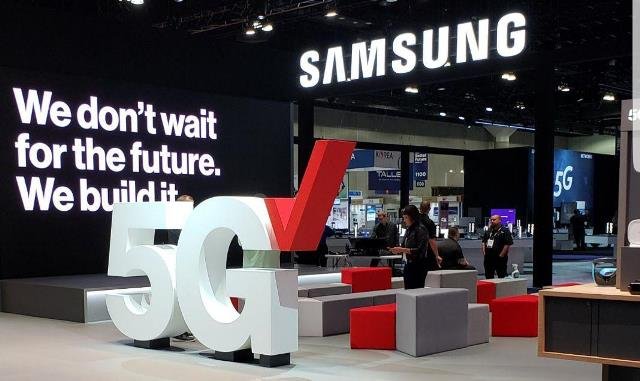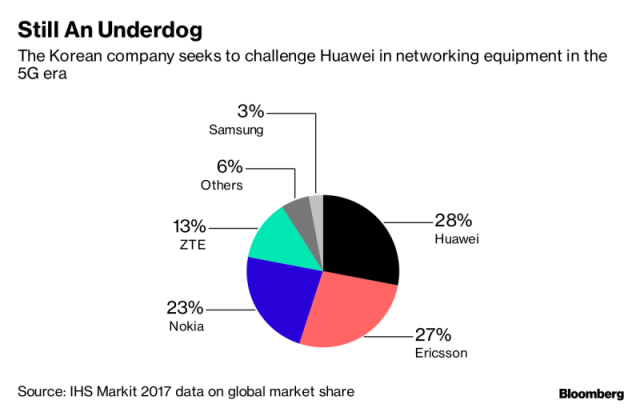Samsung Electronics announced it shipped 36,000 5G base stations to the US and Korea in 2018.

The development assumes importance because Huawei, the largest telecom network maker, is unable to sell its networking products in the US. US President Donald Trump on Thursday called on US telecom companies to boost their work to build 5G wireless communications networks.
Huawei has lost considerable 5G base station business to Samsung last year. Verizon and rival AT&T will use Samsung and Ericsson base stations. AT&T will also be using Nokia 5G base stations. T-Mobile selected Ericsson and Nokia for 5G push.
South Korea’s three mobile carriers have already selected Samsung, Ericsson and Nokia as 5G infrastructure suppliers, with LG Uplus also sourcing equipment from Huawei. They launched 5G for business used in December 2018 and will offer 5G mobile for retail users this year.

Samsung innovation
Samsung said it completed the development of its 5G mmWave chipsets supporting 28GHz and 39GHz bands.
Samsung said its new RFICs and DAFE ASICs – the core components in the 5G chipset – enable about 25 percent reduction in size, weight and power consumption for 5G base stations. 5G base stations using these new chipsets are more efficient in operation and roll-out.
Paul Kyungwhoon Cheun, head of Networks Business at Samsung, said: “Samsung will continue to accelerate 5G commercialization.”
5G base stations use almost one thousand antenna elements and several RFICs to utilize the mmWave spectrum to achieve ultra-fast data speeds. The adoption of RFICs plays a crucial role in supporting the reduction in size and power consumption of base stations.
Samsung’s new RFICs using 28nm CMOS semiconductor technology operate on bandwidths up to 1.4GHz, compared to 800MHz for previous RFICs. Samsung reduced the size of RFIC by 36 percent and enhanced performance by decreasing the noise level and improving the linearity characteristics of the RF power amplifier.
Samsung has developed RFIC solutions for 28GHz and 39GHz and plans to commercialize additional RFICs for 24GHz and 47GHz this year.
Samsung has also developed its own DAFE as an ASIC, low in power consumption and small in size. The company said developing an ASIC allows for the reduction in size and power consumption of 5G base stations. Without investing in ASICs, the DAFE would be too big and power insufficient to meet the product needs of carriers.
“Samsung is building on its 5G leadership with its innovative solutions including low-power RFICs and DAFE ASICs to pioneer a new era of digital transformation,” said Jaeho Jeon, head of R&D, Networks Business at Samsung Electronics.
Earlier, Samsung announced a 5G NR data connection using 400MHz of bandwidth in the 28GHz spectrum, offering throughput of more than 1.7 Gbps.
The data connection in association with Qualcomm and Verizon demonstrated the delivery of 5G speeds to a smartphone form-factor mobile test device. The 5G test used Samsung’s 5G NR and 4G LTE equipment to deliver 5G NR data transmission using Verizon’s 28 GHz spectrum.
Ed Chan, chief technology architect for Verizon, said: “This is a demonstration of real 5G speed achieved through commercial grade Samsung network equipment and a Qualcomm chipset.”
Meanwhile, Anritsu, a testing solutions company, announced the submission of the industry’s first Protocol Conformance test in the Sub-6 GHz Frequency Range 1 (FR1) to 3GPP RAN5 working group for approval.
The test has been verified with the Exynos Modem 5100 5G NR modem developed by Samsung’s System LSI Business on the Anritsu ME7834NR Protocol Conformance test system.
Samsung announced its partnership with Hewlett Packard Enterprise (HPE) to offer solutions for virtual radio access networks (vRAN) and for 5G core networks to telecom operators
The 5G vRAN solution be leveraging Samsung’s vRAN software solutions and the new HPE Edgeline EL8000 Converged Edge System, Phil Davis, president Hybrid IT, chief sales officer of HPE, said.
HPE and Samsung will also deliver joint 5G core solutions. The initial offering will include Samsung Packet Core software products and selected HPE 5G core network function (NF) software products, to streamline the transition to 5G and address periods of overlap of 5G with 4G and 3G.
Baburajan K
